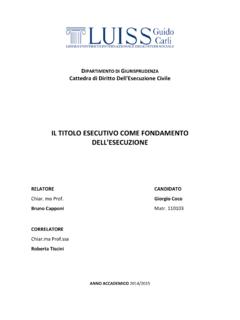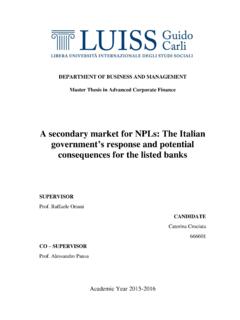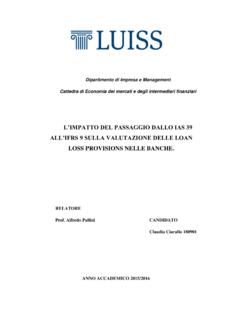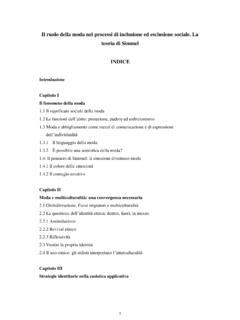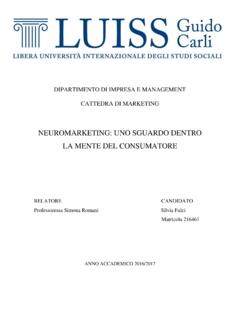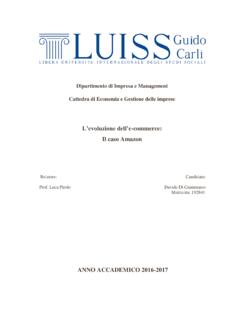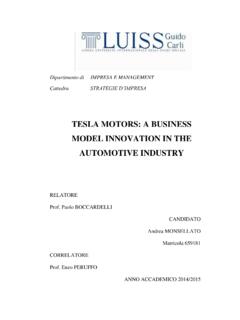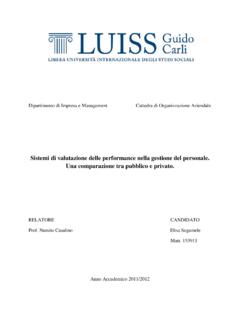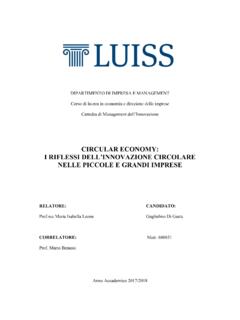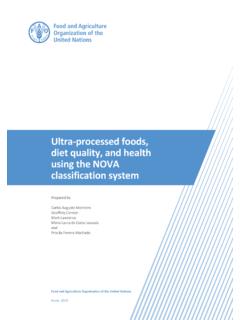Transcription of THE FOOD INDUSTRY: HISTORY, EVOLUTION AND CURRENT …
1 THE food industry : HISTORY, EVOLUTION AND CURRENT TRENDS Department of Business and Economics Subject: Management Supervisor: Paolo Boccardelli Examinee: Gaia Bruna Patrizia Recordati 177941 Academic Year: 2014/2015 TABLE OF CONTENTS: Abstract: (1-2) Introduction: (3-6) Chapter 1: Consumer behavior: the study that never stops to vary and evolve in time - Behavioral analysis: how did it start: (7-13) - General consumer behavior models: psychology, sociology and economics; different fields that try to find the same responses: (13-17) - Contemporary consumer behavior models: the role of interpersonal causations ; the consumers are information processors : (17-25) - Consumer decision process: the question to which behavioral analysis seeks an answer: (25-27) - The business model: how to create value and earn profits: (27-33) Chapter 2: The Fast food Nation - Industrialization of the food industry and the birth of processed foods in North America: (34-36) - The propagation of restaurants, its benefits and disadvantages: (36-40) - New trends: experience, health, sustainability, convenience and pleasure: (41-49) Chapter 3: Flexibility: the key to success - A&W All American food : it s all about tradition, standardization and speed of service: (50-66) - Panera Bread : personalization, healthiness, freshness and quality are the new sources of success: (67-82) Conclusion: (83) Bibliography Sitography 1 ABSTRACT: Since prehistory, when life on earth began, human beings have fought and struggled for food .
2 With the passing of the centuries, humans started to cultivate the land, to farm and to raise animals in order to make eating easier and less laborious. Eventually people started to barter, and later to sell their products, to exchange food for other goods or to earn profits from them. The sources of food have increased dramatically and continued to change over time. While people in the past had to fight to find their daily meals, nowadays we who live in the Western world are continuously surrounded by promotions and advertisements for food products of different types, qualities and prices. Although it might seem contradictory, in the distant past it was very simple for people to make decisions about what they would or could eat: they just hunted whichever animal was easily available to provide the most nutritious meal. Human beings, without knowing it, had an optimal diet: rich in lean proteins, fruits and vegetables.
3 With civilization, industrialization, technological innovations, mechanization, the economic growth and increasing welfare of people, especially in the 20th century, the situation has changed drastically. People are spoilt; they no longer look for food with healthy nutrients, instead they are attracted by those foods that seem more attractive and tasty. Often these products are high in carbohydrates, sugars and trans fats and are low in vitamins and proteins. Indeed, during the twentieth century, the food industry underwent the biggest transformation in its history. food distributors started to look for faster and more convenient ways to produce their products: standardization, concentration, automation and simplification seemed to be the key to success. It was during these years, in 1922, that the world s first fast food company was founded: A&W All American food . In my work I will analyze how this firm has managed to remain successful over several decades in the highly competitive food market.
4 At the time it was founded, the food industry was not stable. America, like the rest of the world was facing the hardships and problems of shortage of materials and of employees in the wake of WWII and only the most structured and flexible firms managed to survive. Firms continued to increase the level of processed foods, using synthetic fertilizers and mechanization in 2 order maximize profits, and to reduce the costs and maximize the outputs. At that time this seemed the best way to feed people and to make both consumers and producers happy, by introducing low prices and high profits. However, this solution did not last for long. Soon researchers and doctors showed that the changes in eating habits together with the food production system, were having dramatic consequences on people s health, not to mention the environment. Data showed that Americans ate on average 20% more calories in 2000 then they did in 1983, and that the level of obesity has reached the alarming number of million adults in Many younger firms, such as Panera Bread, have understood the severity of this problem and have adapted in order to meet new consumer requirements.
5 In the last part of my dissertation I analyze this iconic American cafeteria and restaurant chain in order to understand how old and new restaurants are adapting to the changing trends within the food industry . In my conclusion, I suggest an answer for their success and show how two different and sometimes opposing firms have managed to become leaders in the food market. 3 INTRODUCTION: The food industry has changed and developed over the decades in order to satisfy customer needs and consumer behavior. This industry is characterized by a complex system of activities concerning supply, consumption and delivery of food products across the entire globe. My dissertation will focus on the history of the American food industry , concentrating on the development of the market from World War II (WWII) until today. Before WW II, all over the world the people used to eat in very simple ways using only local and seasonal products as they were constrained to a geographical area.
6 Another important change occurred in the role that women played within their family: as the men left to fight in the war the female population had to replace them working in industry . While their disposable income increased, the time they could dedicate to housework decreased drastically, with a consequent rise in demand for industries that could produce readymade food in their place. After the war, the processed food that was initially developed for soldiers on the frontline became produce for grocery stores and restaurants in towns and cities. This phenomenon became even more evident when Richard and Maurice McDonald understood the importance of making food quickly, selling it cheaply and spending less time and resources in looking for the best quality food sources and in the final product. The two brothers redesigned the food preparation sector, as in the automobile assembly line, in order to achieve the product at a lower cost.
7 McDonald s was the first of a series of fast food restaurants that, in a brief period, managed to compete in the market by offering reasonable products at a low price. 4 However, very soon studies started showing how cardiovascular problems, diabetes, musculoskeletal disorders, cancers and obesity, all diseases related to poor eating habits, were drastically on the increase. The results were analyzed by several scientists, as, for example, Ancel Keys who observed how, unlike monounsaturated fats, saturated fats caused heart diseases. In 1968, Senator George McGovern, head of the Senate State Committee on Nutrition and Human Needs, started out on a mission to fight bad dietary habits. He worked on several food assistance programs aimed at formulating science based recommendations on which healthy foods Americans should eat in order to lower their risk of heart diseases and other chronic illnesses.
8 The word Dietary Goal was first published in 1977 and stimulated reactions in the scientific community, in the food industry and numerous public health organizations. Soon food producers had to face a new challenge: awareness about healthy nutrition was increasing, the slogan you are what you eat became more and more representative of the people s new mindset. However, whilst people wanted to consume food with no fat, it was actually the fat that gave it flavor and so, once it was removed, the consumer no longer found it attractive. The industry had then to invest millions of dollars adapting to the consumers new requests but also maintaining the products appeal. Not only fast food chains tried to diversify and introduce new lines of products such as salads, fruit and organic food , but also competition between restaurants and fast food chains that offered healthier foods increased.
9 As people looked for healthy alternatives, this phenomenon caused the decline of many conventional fast food companies that in the past had been market leaders. The opening chapter of this dissertation will initially analyze the changes in consumer behavior and the different business models since the last World War. 5 Consumer behavior describes how people make decisions when purchasing goods. Businesses continuously search the solution to this question in order to have a much better chance of creating and producing the right merchandise for the right target consumers at the right time. People make decisions about goods from much earlier than they probably realize. Over time they develop a systematic way to choose from among the alternatives sometimes not even being not aware of it. Other consumers, instead, follow a similar process of making decisions. Business enterprises are established in order to create, deliver and capture prominence with the customer.
10 Whenever a business enterprise is established, it either explicitly or implicitly employs a particular business model that represents the design and architecture of the mechanisms it uses. It thus reflects management s attitudes to what customers want, how they want it, and how the business can best meet those needs, get paid for doing so, and make a profit. In the second chapter of my dissertation I will focus on the American food industry , its development through time and its specific characteristics. By observing its complete story and changes over the decades, clear evidence of market trends, transformation and mechanization will emerge. The one factor of our lifestyle that changed drastically during and after WWII is the way we eat. food had to evolve, and with that EVOLUTION came industrial farming at a scale we had never seen before, mass food preservation through canning or freezing, and a technical revolution in the kitchen.
